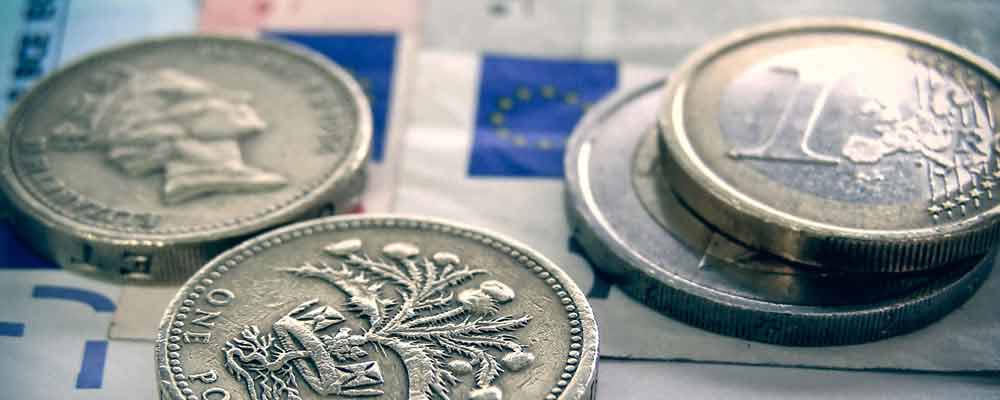- GBP EUR Exchange Rate Hovers Around 1.17 – UK PMI boosts it from worst levels
- Weaker US Dollar Allows Euro to Strengthen – But political concerns limit EUR gains
- Eurozone Retail Sales Mixed – Retail sector sturdy year-on-year
- GBP Forecast: Sterling to see Flat Trade Next Week – Unless Brexit developments shock markets
Pound to Euro Exchange Rate Registers Half a Cent of Losses This Week
Demand for the Pound dropped off in the latter half of the week, and this alongside the week’s better than expected Eurozone figures and mixed US Dollar movement left the Euro putting in one of its best showings in weeks.
Even following the publications of the US Non-Farm Payroll report on Friday afternoon, demand for the Euro remained strong and the shared currency was able to sustain its weekly gains against the Pound. GBP EUR looked to end the week around the region of 1.16.
In the coming week, far less influential UK data will be published with most of the most important UK data coming in on Wednesday. The Eurozone will see the publication of investor confidence survey results and Eurozone retail sales figures on Monday.
(Previously updated 12:57 GMT 06/01/2017)
Friday morning saw the Pound to Euro exchange rate largely continue Thursday’s gradual downward trajectory, as investors remained bearish on the Pound due to this week’s Brexit developments.
The Euro also performed sturdily due to the week’s last set of Eurozone data, which was generally optimistic.
November’s Eurozone retail sales results came in above expectations year-on-year. Expected to drop from 2.4% to 1.8%, the figure merely slowed to 2.3% and the previous score was revised to a higher 3%.
December’s Eurozone business confidence results also impressed, jumping from 0.41 to 0.8. However, the Euro could still weaken before the end of the day if the US Dollar (USD) turns bullish on the afternoon’s US Non-Farm Payroll report.
(Published 07:00 GMT 05/01/2017)
The Pound is approaching the weekend trading below the week’s opening levels against the Euro despite a hat trick of better-than-expected UK PMIs from Markit.
GBP EUR had been eyeing the level of 1.18 but as the week progressed the Pound fell back to the cusp of 1.17.
While the Pound’s losses against the common currency were partially due to increased strength in the Euro, Brexit jitters kept Sterling pressured.
Concerns worsened that the UK is heading for a ‘hard Brexit’ after the sudden resignation of senior UK ambassador to the EU, Sir Ivan Rogers.
A replacement for Rogers was quickly picked, Sir Tim Barrow. However, this was not enough to put traders at ease as Rogers had made it clear during his resignation that the UK government lacked a cohesive exit strategy and a strong negotiating team.
This is part of why Sterling was unable to benefit from the week’s strong trio of UK PMIs from Markit. Manufacturing and construction sector growth beat expectations, as did output in Britain’s biggest sector – services.
The services PMI came in at 56.2, gaining from November’s 55.2 despite being predicted to fall to 54.7. Markit’s composite print also impressed, beating forecasts of 55 to hit a solid 56.7.
These figures bolstered hopes that the UK economy would continue to perform well in the build up to the beginning of the formal Brexit process, but comments from Markit Chief economist Chris Williamson dulled hopes that this could lead to tighter monetary policy from the Bank of England (BoE);
‘policymakers are clearly concerned about the extent to which Brexit-related uncertainty could slow growth this year. They will therefore consider the current resilience of the economy alongside the elevated levels of uncertainty highlighted by the historical weakness of business optimism about the year ahead.’
Meanwhile, despite a slew of optimistic Eurozone ecostats this week, the Euro has struggled to capitalise, largely due to strong underlying bearishness amid 2017’s European political concerns and the enduring strength of the US Dollar.
However, as demand for the US Dollar faded later in the week and Eurozone reports kept impressing EUR was able to firm.
Wednesday saw the publication of preliminary December Consumer Price Index (CPI) figure for the Euro bloc. The figure improved from 0.6% to 1.1% year-on-year, bolstered by strong German inflation.
GBP EUR 2017 Forecast: Further Losses Expected?
Friday’s European session will see the publication of Germany’s November factory orders and retail sales results, as well as the retail sales figures for the Eurozone. If these figures impress, it could cause GBP EUR to continue its current downward trajectory for the remainder of the week.
However, US Non-Farm Payroll figures due during the American session could weigh on the Euro considerably if they impress and inspire traders to turn bullish on the US Dollar (USD).
Unless the Euro weakens, the GBP EUR exchange rate is on track to lose around half a cent in value this week.



